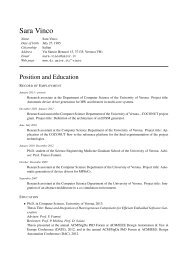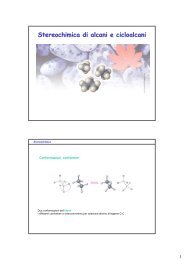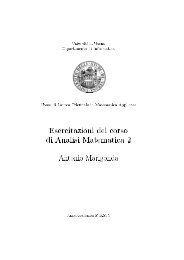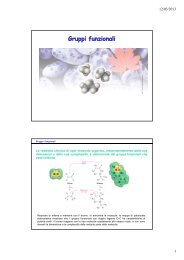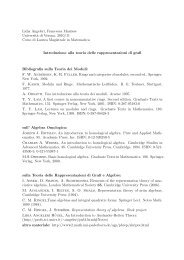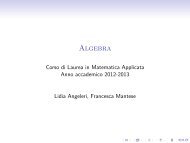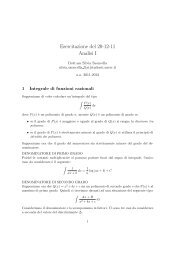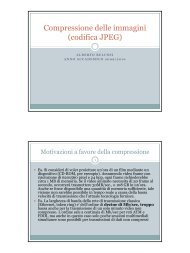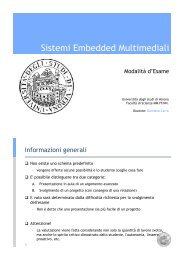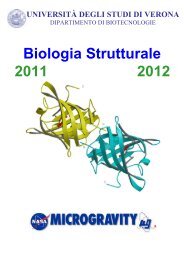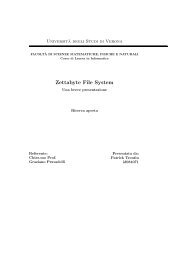You also want an ePaper? Increase the reach of your titles
YUMPU automatically turns print PDFs into web optimized ePapers that Google loves.
32. MISCELLANEA DI ESERCIZI SUPPLEMENTARI 175<br />
(4) Una base dello spazio tangente è data dalle colonne della matrice Jacobiana di ϕ. In particolare,<br />
nel punto (a, 0, 0) = ϕ(0, 0) si ha (0, a, 0) e (0, 0, a). La normale deve essere ortogonale a questi due<br />
vettori, e avere norma uno, per cui è della forma (±1, 0, 0). Verifichiamo quale di questi due è la<br />
normale indotta dalla parametrizzazione:<br />
⎛<br />
det ⎝<br />
±1 0 0<br />
0 0 a<br />
0 a 0<br />
⎞<br />
= ⎠ = ∓a 2 .<br />
Il determinante deve essere pos<strong>it</strong>ivo, per cui la normale indotta nel punto (a, 0, 0) è (−1, 0, 0).<br />
(5) Il flusso richiesto vale:<br />
Φ(Sa, ⎛<br />
2π F1 ◦ ϕ −<br />
1 ⎜<br />
F ) = det ⎜<br />
⎝<br />
0 −1<br />
y2 + a2 y cos θ<br />
sin θ √<br />
y2 +a2 F2 ◦ ϕ 0 1<br />
F3 ◦ ϕ y2 + a2 ⎞<br />
⎟<br />
⎠ dy dθ<br />
y sin θ<br />
cos θ √<br />
y2 +a2 ⎛<br />
2π (y<br />
1 ⎜<br />
= det ⎜<br />
⎝<br />
0 −1<br />
2 + a2 ) cos2 θ − y2 + a2 ⎞<br />
y cos θ<br />
sin θ √<br />
y2 +a2 ⎟<br />
<br />
y/2 0 1 ⎟<br />
⎠ dy dθ<br />
y2 + 1 cos θ y2 + a2 y sin θ<br />
cos θ √<br />
y2 +a2 ⎛<br />
2π 1<br />
= (−y/2)det ⎝ −y2 + a2 ⎞<br />
y cos θ<br />
sin θ √<br />
y2 +a2 ⎠ dy dθ+<br />
y2 + a2 cos θ<br />
=<br />
+<br />
0 −1<br />
2π 1<br />
0 −1<br />
2π 1<br />
0<br />
−1<br />
√y sin θ<br />
y2 +a2 <br />
2 2 2 (y + a ) cos θ − y2 + a2 sin θ<br />
(−1)det dy dθ<br />
y2 + 1 cos θ y2 + a2 cos θ<br />
y 2 1 2π <br />
/2 dy dθ + (y 2 + a 2 ) 3/2 cos 3 θ + (y 2 + a 2 <br />
) sin θ cos θ dθ dy<br />
−1<br />
= 2<br />
3 π.<br />
Nell’ultimo passaggio è sfruttato il fatto che:<br />
2π<br />
0<br />
cos θ sin θ dθ = 1<br />
2<br />
2π<br />
0<br />
cos 3 θ dθ =<br />
=<br />
=<br />
2π<br />
0<br />
3π/2<br />
−π/2<br />
π/2<br />
−π/2<br />
1<br />
−1<br />
0<br />
sin(2θ) dθ = 1<br />
4<br />
cos 3 θ dθ =<br />
4π<br />
0<br />
3π/2<br />
−π/2<br />
(1 − sin 2 θ) cos θ dθ +<br />
(1 − w 2 ) dw +<br />
−1<br />
1<br />
sin w dw = 0.<br />
<br />
(1 − sin 2 θ) cos θ dθ<br />
3/2π<br />
π/2<br />
(1 − w 2 ) dw = 0.<br />
(1 − sin 2 θ) cos θ dθ<br />
Esercizio 32.16. Nel piano x = 0, si consideri la curva γ(y) = y2 (1 − y2 <br />
) + 1 per t ∈ [0, α] dove α =<br />
(1 + √ 5)/2 e la superficie S ottenuta ruotando γ attorno all’asse z e orientata in modo che nel punto (0, 0, 1)<br />
il versore normale sia diretto verso l’alto. Si definisca inoltre il campo vettoriale F : R 3 → R 3<br />
F (x, y, z) = (e 4y , x − x 2 , z).<br />
(1) Si calcolino la divergenza e il rotore di F .<br />
(2) Si tracci il grafico di γ.<br />
(3) Si scriva una parametrizzazione di S e si determini il relativo elemento di superficie 2-dimensionale.<br />
(4) Si calcoli il flusso di F attraverso S.<br />
(5) Si dica se F è conservativo. In caso negativo, si esibisca un circu<strong>it</strong>o ˜γ dove la circu<strong>it</strong>azione di F sia<br />
non nulla (sugg. si utilizzi il teorema di Stokes applicato ad un’opportuna superficie giacente nel piano<br />
z = 0, il cui bordo sarà il circu<strong>it</strong>o desiderato).<br />
Svolgimento. Poniamo F = (F1, F2, F3).



